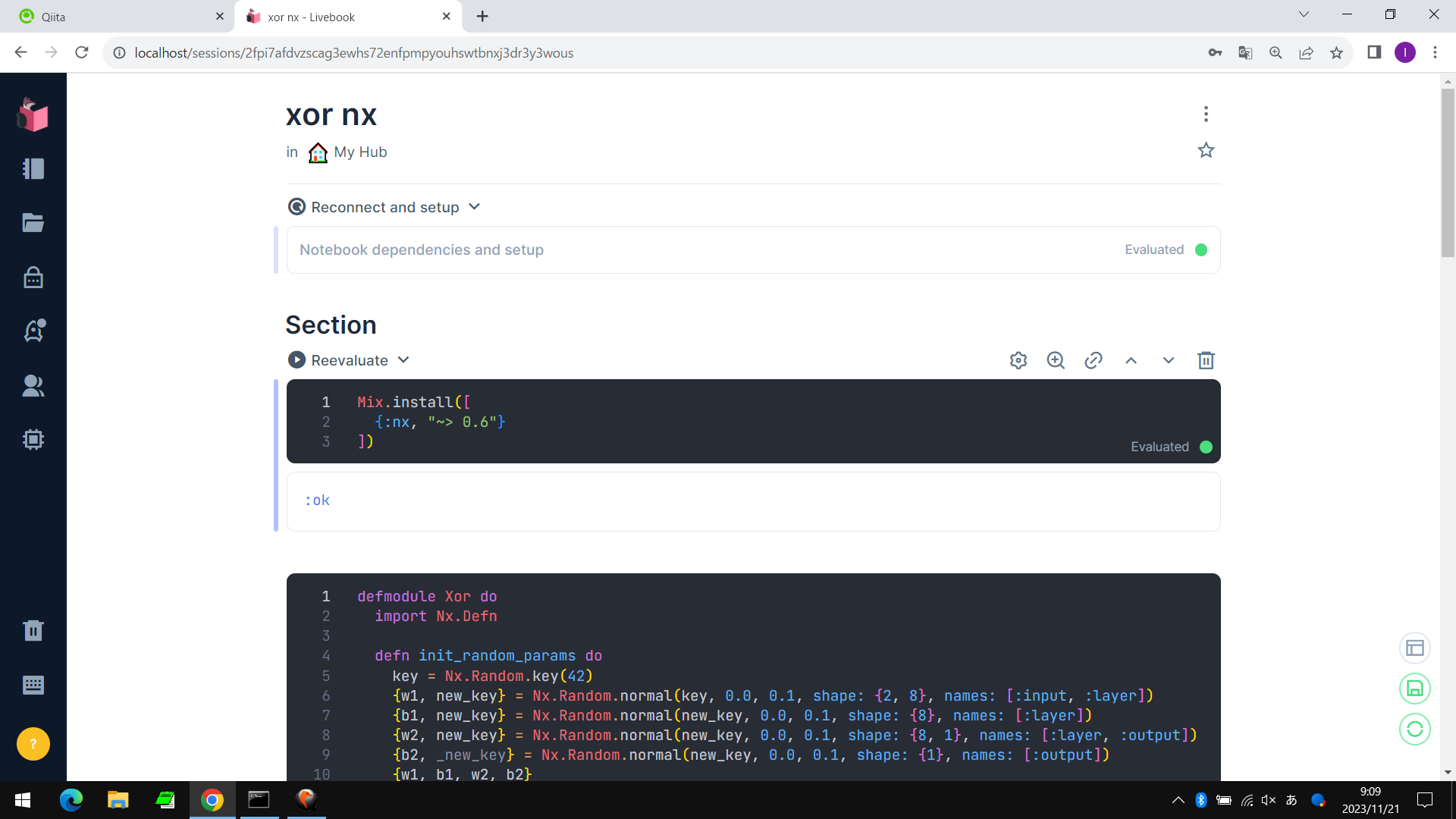概要
wsl(wsl2じゃない)でnervesやってみる。
qemu(x86_64エミュレータ、ラズパイじゃない)でやってみた。
生成したnerves_livebook.imgを、quemで起動してテストしてみた。
練習問題、やってみた。
練習問題
nxを使え。
写真
セットアップ
Mix.install([
{:nx, "~> 0.6"}
])
サンプルコード
xorを学習して、推定する。
defmodule Xor do
import Nx.Defn
defn init_random_params do
key = Nx.Random.key(42)
{w1, new_key} = Nx.Random.normal(key, 0.0, 0.1, shape: {2, 8}, names: [:input, :layer])
{b1, new_key} = Nx.Random.normal(new_key, 0.0, 0.1, shape: {8}, names: [:layer])
{w2, new_key} = Nx.Random.normal(new_key, 0.0, 0.1, shape: {8, 1}, names: [:layer, :output])
{b2, _new_key} = Nx.Random.normal(new_key, 0.0, 0.1, shape: {1}, names: [:output])
{w1, b1, w2, b2}
end
defn predict({w1, b1, w2, b2}, x) do
x
|> Nx.dot(w1)
|> Nx.add(b1)
|> Nx.tanh()
|> Nx.dot(w2)
|> Nx.add(b2)
|> Nx.sigmoid()
end
defn loss({w1, b1, w2, b2}, x, y) do
preds = predict({w1, b1, w2, b2}, x)
Nx.mean(Nx.power(y - preds, 2))
end
defn update({w1, b1, w2, b2} = params, x, y, step) do
{grad_w1, grad_b1, grad_w2, grad_b2} = grad(params, &loss(&1, x, y))
{w1 - grad_w1 * step, b1 - grad_b1 * step, w2 - grad_w2 * step, b2 - grad_b2 * step}
end
def train(params, x, y) do
for i <- 0..31, reduce: params do
acc ->
update(acc, x[i], y[i], 0.1)
end
end
end
z0 = for _ <- 0..31, do: Enum.random(0..1)
z1 = for _ <- 0..31, do: Enum.random(0..1)
x0 = Nx.tensor(z0)
x1 = Nx.tensor(z1)
y = Nx.logical_xor(x0, x1)
x = Nx.concatenate([Nx.reshape(x0, {32, 1}), Nx.reshape(x1, {32, 1})], axis: 1)
params = Xor.init_random_params()
Xor.loss(params, x[0], y[0])
|> IO.inspect()
params =
for i <- 0..310, reduce: params do
acc ->
for i <- 0..31, reduce: acc do
bcc ->
Xor.update(bcc, x[i], y[i], 0.1)
end
end
Xor.loss(params, x[0], y[0])
|> IO.inspect()
IO.puts("0 1")
Xor.predict(params, Nx.tensor([0, 1]))
|> IO.inspect()
IO.puts("0 0")
Xor.predict(params, Nx.tensor([0, 0]))
|> IO.inspect()
IO.puts("1 1")
Xor.predict(params, Nx.tensor([1, 1]))
|> IO.inspect()
IO.puts("1 0")
Xor.predict(params, Nx.tensor([1, 0]))
|> IO.inspect()
実行結果
warning: variable "i" is unused (if the variable is not meant to be used, prefix it with an underscore)
/data/livebook/xor.livemd#cell:zc3vabsfd6ftw2ineimecdebjxd3whxt:54
#Nx.Tensor<
f32
0.2594543695449829
>
#Nx.Tensor<
f32
9.000560385175049e-4
>
0 1
#Nx.Tensor<
f32[output: 1]
[0.9725738763809204]
>
0 0
#Nx.Tensor<
f32[output: 1]
[0.03000093437731266]
>
1 1
#Nx.Tensor<
f32[output: 1]
[0.02718157321214676]
>
1 0
#Nx.Tensor<
f32[output: 1]
[0.9590940475463867]
>
warning: Nx.power/2 is deprecated. Use pow/2 instead
/data/livebook/xor.livemd#cell:zc3vabsfd6ftw2ineimecdebjxd3whxt:25: Xor."__defn:loss__"/3
以上。
